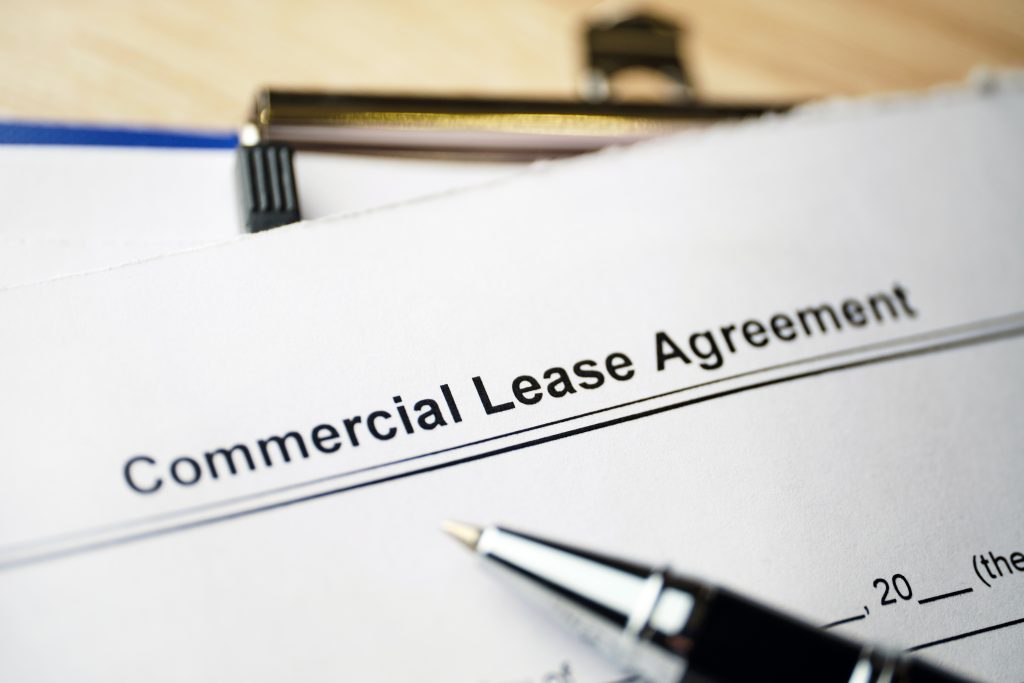
Commercial leases can be confusing, especially if you’ve never leased a commercial property before. There are many different types of leases, making it extremely important to understand the main differences between them to make the most informed decision for your business. Opting for the correct commercial lease based on your goals and growth trajectory can make or break your business, particularly in the early stages.
Our team of commercial property experts have put together this handy guide introducing the types of commercial leases commonly seen in the UK. Unsure of which type of commercial lease best suits your business? Read on to discover more!
What is a Commercial Lease?
A commercial lease is a contract between a landlord and tenant for the use of commercial property. In exchange for rent payments, this lease gives the tenant rights to use the property for their business activities for an agreed-upon length of time. Commercial leases also typically serve to clearly outline the specific rights and responsibilities of each party in the agreement. These rights and responsibilities often include whether tenants are able to sublease space to another party, the terms of breaking the lease, and a wide range of additional factors.
Commercial lease agreements are typically used for office space, retail stores, and industrial facilities. When signing a commercial lease, it is important to carefully review the terms and conditions to ensure that they meet your business needs. For example, you will need to determine how much space you will need, how long you will need it, and what type of business activities will be permitted. It is also critical to be aware of your rights and responsibilities under the lease agreement. For example, you may have the right to sublet the property or make alterations, but you may also be responsible for repairs or cleaning. By understanding the terms of your lease, you can help ensure that your business has the space it needs to thrive.

Types of Commercial Leases
Gross Lease
Also known as a full service lease, a gross lease is a type of commercial lease in the United Kingdom in which the tenant pays a single, all-inclusive rental fee to the landlord each month. This includes rent for the use of the property, as well as any other building expenses such as utilities, janitorial services, and property insurance. Additionally, gross leases place the responsibility for property tax and insurance costs on landlords. The main advantage of a gross lease is that it provides the tenant with a predictable monthly rental expense, making it easier to budget for other business expenses. In addition, gross leases often include a provision for annual rent increases, which can help the tenant keep up with rising costs over time. However, gross leases typically have longer terms than other types of commercial leases, so the tenant may be required to make a significant upfront investment.
Modified Gross Lease
In the United Kingdom, a modified gross lease is a type of commercial lease in which the base rent is usually quoted as a monthly amount. However, the lessee may also be responsible for paying a proportion of the property’s running costs, such as maintenance, repairs, and insurance. The terms of a modified gross lease can vary considerably, so it is important to ensure that you understand all the terms and conditions before signing on the dotted line. Although modified gross leases are becoming more popular in the UK, they are still relatively uncommon compared to other types of leases. As such, you may need to do some research to find properties that offer this type of lease. However, if negotiated correctly, a modified gross lease can offer considerable benefits for both landlords and tenants.

Net Lease
A net lease is a type of commercial lease in which the tenant is responsible for paying a portion of the property taxes, insurance, and maintenance costs in addition to their monthly rent. This can be beneficial for landlords because it means they have less responsibility for the upkeep of the property. They’re also advantageous for tenants because they can allow them to control their own costs and budget more effectively. Net leases are typically used for office buildings, retail spaces, and industrial warehouses. When negotiating a net lease, it is important to clearly define the terms of the agreement so that there are no misunderstandings later on.
Single Net Lease
Single net leases pass the cost of property taxes onto tenants rather than landlords. This type of commercial lease is rarely found in the UK, with double and triple net leases often far more common. Under a single net lease, tenants are simply responsible for rental costs and property taxes.
Double Net Lease
Far more prevalent than single net leases, double net leases pass both property taxes and insurance costs to the tenant. This type of commercial lease leaves maintenance costs with the landlord, something which makes logical sense for businesses leasing space within a large building housing multiple occupants.
A double net lease is often sought after due to the flexibility it provides for both parties, allowing landlords to focus on maintenance and upkeep of the building at large, whilst tenants manage insurance and taxes based on their unique situations.
Triple Net Lease
A triple net lease (NNN lease) is a type of commercial lease in which the tenant is responsible for all the property’s operating expenses, including property taxes, insurance, and maintenance. The term “triple net” refers to the three main types of expenses that are typically covered by the tenant. In most cases, these leases are used for entire properties that are leased to businesses, such as office buildings, retail stores, and warehouses.
Triple net leases are often used by landlords because they provide a greater degree of financial predictability and stability. Because the tenant is responsible for all operating expenses, the landlord knows exactly how much rent they will receive each month. This type of lease can also be attractive to tenants because it can offer a lower monthly rental rate. However, it is important to remember that the tenant will be responsible for all unexpected repair and maintenance costs.

Percentage Lease
A percentage lease involves a tenant paying a portion of their profits to the landlord in addition to a base rental rate. The percentage of profits paid to the landlord differs from lease to lease, as does the point at which this percentage payment comes into effect – otherwise known as the break-even point. Percentage leases are commonly used for retail businesses, such as restaurants and stores. They are also occasionally used for office space and other types of commercial space.
The main advantage of a percentage lease is that it allows the landlord to share in the tenant’s success. If the tenant does well, they will pay more rent, but if they do poorly, they will pay less. This can be beneficial for both parties, as it gives the tenant an incentive to do well, while also providing some stability for the landlord. Percentage leases also allow landlords to strategically place businesses in the same location (e.g. a shopping centre or mixed-use building) in order to bolster profits and share in success. For example, a landlord looking for a boutique dress shop to complement other stores within a shopping centre might offer a percentage lease to a promising business unable to afford other types of commercial leases. This landlord would be banking on the success of the dress shop due to the synergy provided by surrounding businesses.
However, percentage leases can also be risky, as they can potentially lead to large swings in rent payments. For this reason, they are not always suitable for all types of businesses.

What About Subleasing?
A sublease is a contract between a tenant and a subtenant that allows the subtenant to use commercial space leased by the tenant. The tenant remains responsible for paying rent to the landlord and is also responsible for the subtenant’s compliance with the terms of the lease agreement. Subleasing can be a good option for businesses that need to downsize their operations or temporarily relocate to another city. It can also be a way for businesses to generate income by renting out unused space.
By subleasing, you can take on a smaller or shorter lease than if you were to lease the property outright. This can be especially beneficial if your business is in its early stages, and you are not yet sure how much space you will need.
There are a few things to bear in mind when subleasing office space. Firstly, make sure that you read and understand the terms of your original lease agreement. You will usually need the permission of your landlord to sublease, so it is important to check that this is included in your contract. Secondly, it is essential to find good tenants for your property. Ask around for recommendations, or use an online letting agent. Finally, remember that you will still be responsible for the property, even if it is not officially in your name. This means that you will need to ensure that it is well-maintained and that any repairs are carried out promptly. By following these simple tips, subleasing office space can be a great way to save money on your business premises.

Where do Coworking Spaces Fit?
Coworking spaces are typically considered an alternative to more traditional commercial office leases. These flexible agreements often occupy a grey area, with the all-inclusive pricing structures that are found in most coworking spaces walking the line of a full gross commercial lease. As with a lot of other things, the truth of the matter will vary from circumstance to circumstance. A lot of coworking agreements come with several unique nuances that make it hard to paint all coworking experiences with a broad brush. For example, some businesses may work out of a coworking space for years and their employees may have specifically allocated desks from which to work. On the other hand, there are plenty of businesses that utilise coworking facilities for days or weeks whilst transitioning between spaces or visiting clients.

How to Decide Which Type of Office Lease is Best for Your Business
The type of commercial lease that you choose will depend on numerous factors, including the nature of your business, current growth trajectory, budget, requirements, and the type of property you’re looking to lease. True gross leases are a good option for tenants looking to pay a simple, all-inclusive rental fee without the hassle of property taxes, insurance, maintenance, and other operational costs. However, all-inclusive true gross leases are often more expensive due to their simplicity. Businesses looking to exercise more control would be wise to look at net leases, which come with additional burdens coupled with typically cheaper prices.
Ultimately, the different types of commercial leases outlined in this guide each allocate different levels of risk and responsibility to tenants and landlords alike. As a general rule of thumb, most commercial property leases feature cheaper base rents when landlords have less responsibility over the running of the space. Large companies that are happy to accept tax, insurance, and maintenance costs would be wise to explore net leases. Smaller companies, such as startups, should consider spaces offering modified gross leases, subleases, and flexible space.
As you can see, there are a number of different types of commercial leases available in the UK. Each option has its advantages and disadvantages, so it is important to choose the right one for your business. If you are unsure about which type of lease is best for your needs, then it is always advisable to speak to one of our commercial property experts by calling 020 3965 9617. They will be able to advise you on the best option for your specific circumstances.
Looking for more content?
For more deep dives into commercial real estate, you can visit the articles below. Additionally, you can view our full range of serviced offices and coworking spaces or, alternatively, call one of our London commercial property experts on 020 3965 9617.
13 Desk Decor Ideas for Eye-Catching Office Spaces
Average Salary in the City of London
The Best Business Parks in London
Digital Transformation Across Industries: From Banking to Retail
Central London Office Market Report Q2 2022
The 10 Workplace Trends Defining 2022 So Far
Iconic and Influential Office Spaces in London
Do Employees Feel Supported by Their Managers After the Pandemic? (2022 Poll)
UK Office Workers Polled: Characteristics of a Good Manager
London Office Market Sees Highest Level of Occupier Activity Since Before the Pandemic
How to Deal with the Stress of Returning to the Office after a Long Layoff
10 Ways to Improve Office Moral
